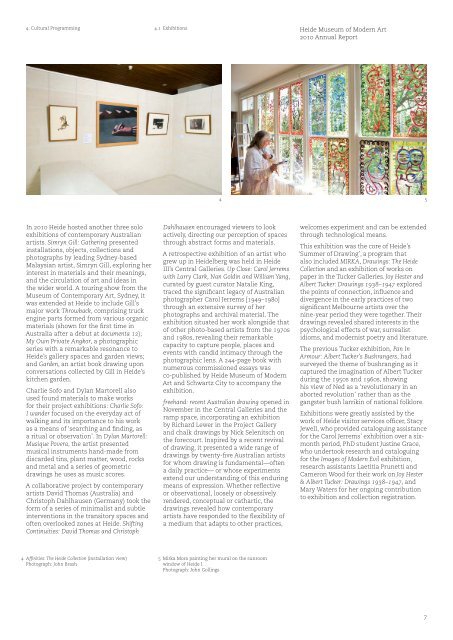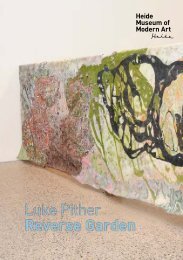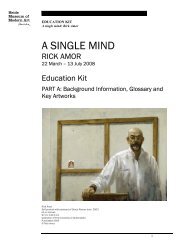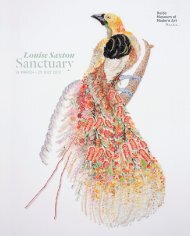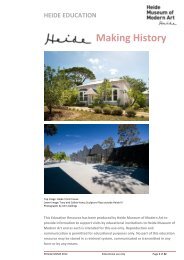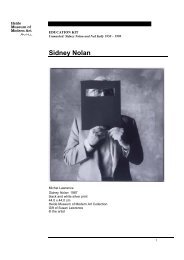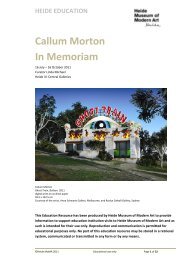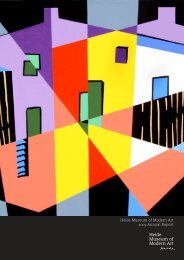Heide Museum of Modern Art 2010 Annual Report
Heide Museum of Modern Art 2010 Annual Report
Heide Museum of Modern Art 2010 Annual Report
Create successful ePaper yourself
Turn your PDF publications into a flip-book with our unique Google optimized e-Paper software.
4. Cultural Programming<br />
In <strong>2010</strong> <strong>Heide</strong> hosted another three solo<br />
exhibitions <strong>of</strong> contemporary Australian<br />
artists. Simryn Gill: Gathering presented<br />
installations, objects, collections and<br />
photographs by leading Sydney-based<br />
Malaysian artist, Simryn Gill, exploring her<br />
interest in materials and their meanings,<br />
and the circulation <strong>of</strong> art and ideas in<br />
the wider world. A touring show from the<br />
<strong>Museum</strong> <strong>of</strong> Contemporary <strong>Art</strong>, Sydney, it<br />
was extended at <strong>Heide</strong> to include Gill’s<br />
major work Throwback, comprising truck<br />
engine parts formed from various organic<br />
materials (shown for the first time in<br />
Australia after a debut at documenta 12);<br />
My Own Private Angkor, a photographic<br />
series with a remarkable resonance to<br />
<strong>Heide</strong>’s gallery spaces and garden views;<br />
and Garden, an artist book drawing upon<br />
conversations collected by Gill in <strong>Heide</strong>’s<br />
kitchen garden.<br />
Charlie S<strong>of</strong>o and Dylan Martorell also<br />
used found materials to make works<br />
for their project exhibitions: Charlie S<strong>of</strong>o:<br />
I wander focused on the everyday act <strong>of</strong><br />
walking and its importance to his work<br />
as a means <strong>of</strong> ‘searching and finding, as<br />
a ritual or observation’. In Dylan Martorell:<br />
Musique Povera, the artist presented<br />
musical instruments hand-made from<br />
discarded tins, plant matter, wood, rocks<br />
and metal and a series <strong>of</strong> geometric<br />
drawings he uses as music scores.<br />
A collaborative project by contemporary<br />
artists David Thomas (Australia) and<br />
Christoph Dahlhausen (Germany) took the<br />
form <strong>of</strong> a series <strong>of</strong> minimalist and subtle<br />
interventions in the transitory spaces and<br />
<strong>of</strong>ten overlooked zones at <strong>Heide</strong>. Shifting<br />
Continuities: David Thomas and Christoph<br />
4 Affinities: The <strong>Heide</strong> Collection (installation view)<br />
Photograph: John Brash<br />
4.1 Exhibitions<br />
Dahlhausen encouraged viewers to look<br />
actively, directing our perception <strong>of</strong> spaces<br />
through abstract forms and materials.<br />
A retrospective exhibition <strong>of</strong> an artist who<br />
grew up in <strong>Heide</strong>lberg was held in <strong>Heide</strong><br />
III’s Central Galleries. Up Close: Carol Jerrems<br />
with Larry Clark, Nan Goldin and William Yang,<br />
curated by guest curator Natalie King,<br />
traced the significant legacy <strong>of</strong> Australian<br />
photographer Carol Jerrems [1949–1980]<br />
through an extensive survey <strong>of</strong> her<br />
photographs and archival material. The<br />
exhibition situated her work alongside that<br />
<strong>of</strong> other photo-based artists from the 1970s<br />
and 1980s, revealing their remarkable<br />
capacity to capture people, places and<br />
events with candid intimacy through the<br />
photographic lens. A 244-page book with<br />
numerous commissioned essays was<br />
co-published by <strong>Heide</strong> <strong>Museum</strong> <strong>of</strong> <strong>Modern</strong><br />
<strong>Art</strong> and Schwartz City to accompany the<br />
exhibition.<br />
freehand: recent Australian drawing opened in<br />
November in the Central Galleries and the<br />
ramp space, incorporating an exhibition<br />
by Richard Lewer in the Project Gallery<br />
and chalk drawings by Nick Selenitsch on<br />
the forecourt. Inspired by a recent revival<br />
<strong>of</strong> drawing, it presented a wide range <strong>of</strong><br />
drawings by twenty-five Australian artists<br />
for whom drawing is fundamental—<strong>of</strong>ten<br />
a daily practice— or whose experiments<br />
extend our understanding <strong>of</strong> this enduring<br />
means <strong>of</strong> expression. Whether reflective<br />
or observational, loosely or obsessively<br />
rendered, conceptual or cathartic, the<br />
drawings revealed how contemporary<br />
artists have responded to the flexibility <strong>of</strong><br />
a medium that adapts to other practices,<br />
5 Mirka Mora painting her mural on the sunroom<br />
window <strong>of</strong> <strong>Heide</strong> I.<br />
Photograph: John Gollings<br />
<strong>Heide</strong> <strong>Museum</strong> <strong>of</strong> <strong>Modern</strong> <strong>Art</strong><br />
<strong>2010</strong> <strong>Annual</strong> <strong>Report</strong><br />
4 5<br />
welcomes experiment and can be extended<br />
through technological means.<br />
This exhibition was the core <strong>of</strong> <strong>Heide</strong>’s<br />
‘Summer <strong>of</strong> Drawing’, a program that<br />
also included MIRKA, Drawings: The <strong>Heide</strong><br />
Collection and an exhibition <strong>of</strong> works on<br />
paper in the Tucker Galleries. Joy Hester and<br />
Albert Tucker: Drawings 1938–1947 explored<br />
the points <strong>of</strong> connection, influence and<br />
divergence in the early practices <strong>of</strong> two<br />
significant Melbourne artists over the<br />
nine-year period they were together. Their<br />
drawings revealed shared interests in the<br />
psychological effects <strong>of</strong> war, surrealist<br />
idioms, and modernist poetry and literature.<br />
The previous Tucker exhibition, Pan In<br />
Armour: Albert Tucker’s Bushrangers, had<br />
surveyed the theme <strong>of</strong> bushranging as it<br />
captured the imagination <strong>of</strong> Albert Tucker<br />
during the 1950s and 1960s, showing<br />
his view <strong>of</strong> Ned as a ‘revolutionary in an<br />
aborted revolution’ rather than as the<br />
gangster bush larrikin <strong>of</strong> national folklore.<br />
Exhibitions were greatly assisted by the<br />
work <strong>of</strong> <strong>Heide</strong> visitor services <strong>of</strong>ficer, Stacy<br />
Jewell, who provided cataloguing assistance<br />
for the Carol Jerrems’ exhibition over a sixmonth<br />
period, PhD student Justine Grace,<br />
who undertook research and cataloguing<br />
for the Images <strong>of</strong> <strong>Modern</strong> Evil exhibition,<br />
research assistants Laetitia Prunetti and<br />
Cameron Wood for their work on Joy Hester<br />
& Albert Tucker: Drawings 1938–1947, and<br />
Mary Waters for her ongoing contribution<br />
to exhibition and collection registration.<br />
7


